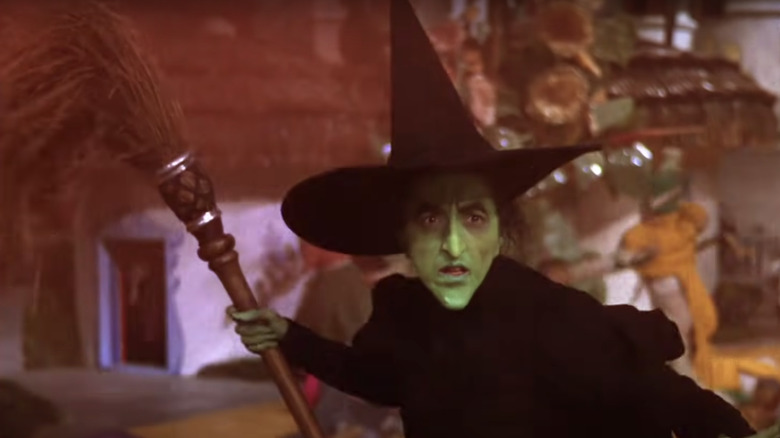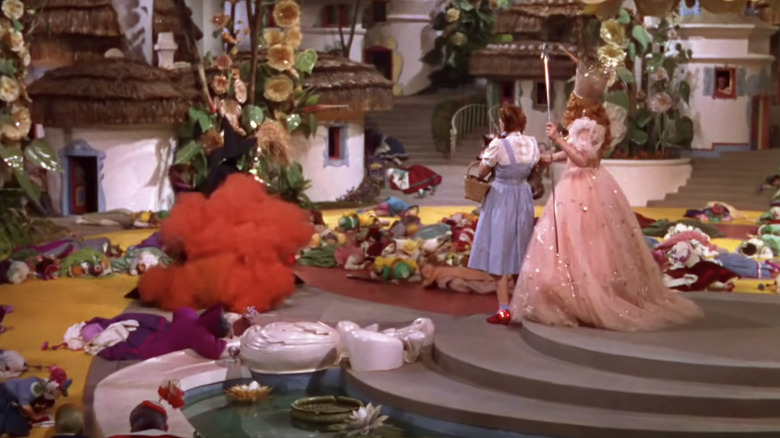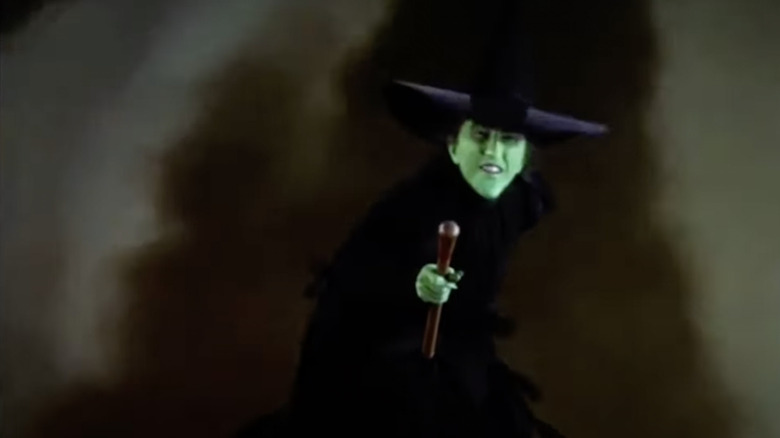How The Wizard Of Oz Changed Margaret Hamilton And Her Stunt Double Forever
Many of us grew up watching "The Wizard of Oz." While the word "iconic" is thrown around a lot these days, I think this film has earned it. Yellow brick roads, red slippers, and flying monkeys are all symbols we constantly encounter throughout pop culture. Oz is a fantasy world of Technicolor wonder and excitement, but the reality is much darker.
The abuse Judy Garland suffered during her time as Dorothy is often discussed today. She was put on a strict diet of soup, coffee, cigarettes, and pills. During filming, she was given uppers to keep her lively, and then she was given downers to sleep a bit before being called back to set to do it all again. In the decades following, Garland continued to experience issues with substance abuse, which led to her death from an accidental overdose at the age of 47.
Unfortunately, Garland wasn't the only actress who suffered in Oz. Margaret Hamilton and her stunt double, who played The Wicked Witch of the West, were literally burned by the production.
'I'll get you, my pretty'
According to Aljean Harmetz's "The Making of The Wizard of Oz," filming the first appearance of The Wicked Witch of the West resulted in the injury of Margaret Hamilton and stuntwoman Betty Danko.
At the beginning of the scene, The Wicked Witch appears in a red cloud of smoke. To pull this off, the crew constructed a hole beneath the set covered by a thin piece of aluminum. Danko was meant to remain inside the hole until her cue, when she would be catapulted into the red smoke. During rehearsal, a crew member fell through the aluminum, into the hole, and landed on Danko's shoulder. The stuntwoman said she could barely drive or raise her arm after the incident.
Director Victor Fleming wanted Hamilton's last line and exit to be shot together. This meant the actress had to do her own stunt. Immediately after the famous line, "I'll get you, my pretty, and your little dog, too," The Wicked Witch cackles, spins on her heels, and disappears in the cloud of smoke and roaring fire. She used the same space under the set, but an elevator replaced the catapult, which Hamilton would land on and use to descend. The first take went as planned. But after breaking for lunch, Fleming wanted another for safety.
They tried the scene four times, but things kept going wrong, and Fleming was losing his patience. Hamilton recalled him telling her, "I want this shot done right and done right now." In the next take, the flames and smoke came before she was safely below set. She suffered second-degree burns on her face and third-degree burns on her hand. To make matters worse, the green makeup covering her body was copper-based and toxic if absorbed, so Hamilton's raw, burned flesh had to be thoroughly cleaned with acetone. Years later, Hamilton remembered:
" I'll never, as long as I live, have anything that [takes] my breath away like that pain."
Surrender, Dorothy
Six weeks later, with exposed nerves in her hand, Margaret Hamilton returned to work. The studio expected her to perform the skywriting scene, which she was assured was safe. When Hamilton was told they were putting her in a fireproof costume, she was not prepared to take any more chances with fire, and she refused to do the shot. Once again, Betty Danko was brought in.
Danko remembers everything going well when she rehearsed the scene with the second unit director, Buddy Gillespie, and the special effects team, but that changed when Victor Fleming got involved. A pipe that would produce smoke was mounted onto the broom, and Danko's cape was pinned over it to hide it. However, Fleming wanted her cape to blow in the wind. The director instructed the special effects team to find a way to hide the pipe underneath her, so they mounted it underneath the broom's bicycle seat. The third time Danko rehearsed the scene, the pipe exploded:
"I felt as though my scalp was coming off. I guess that's because my hat and my black wig were torn loose. They found them, days later, at the top of the stage. The explosion blew me off the broomstick. I managed to grab it with both hands and throw my leg over it. I hung upside down while the men handling the wires lowered the broomstick to the floor and put me face down on the stage ... While I lay there on the floor, waiting for the ambulance, the wardrobe woman came running in, and she said, 'What did you do with the hat? I have to turn it in, you know.'"
Danko spent 11 days in the hospital with a severe, 2-inch-deep burn on her leg, and the studio brought in another stuntwoman to finish the scene.
"The Wizard of Oz" wrapped on March 16, 1939, and I'm sure no one was more relieved than the battered, burned, and bruised cast, but Hamilton's life would never be the same.
'What a world! What a world!'
In reality, Margaret Hamilton was nothing like the green-faced witch, but children couldn't separate her from the character. Reportedly, kids would often come up to the actress and ask why she'd been so mean to Dorothy in the film. That children saw her as the cruel character bothered Hamilton so much she actively took steps to change that. In 1975, Hamilton appeared on an episode of "Mister Rogers' Neighborhood" and changed into a witch costume to explain that The Wicked Witch was a character. She also visited schools and speak to children about the role and, if they asked, give them another glimpse of The Wicked Witch:
"Almost always they want me to laugh like The Witch. And sometimes when I go to schools, if we're in an auditorium, I'll do it. And there's always a funny reaction, like 'Ye gods, we wish they hadn't ask[ed].' They're scared. They're really scared for a second. Even adolescents. I guess for a minute they get the feeling they got when they watched the picture."
Like those kids, I used to enjoy singing along with Dorothy and hating on The Wicked Witch, but it's not that simple anymore. Having pulled back the curtain on the abuse that took place on set and the lasting damage the actors suffered, it is difficult to find my way back to Oz.



